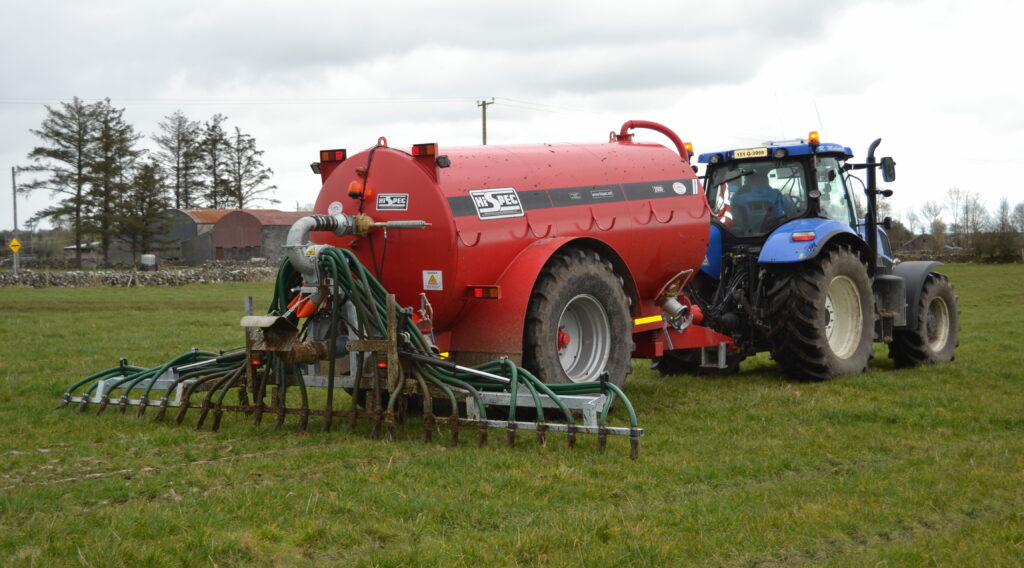Getting soils fertile and healthy for the grazing season will aid the maximising of grass growth on the farm. The priority is to ensure, if spreading chemical or organic fertiliser on the land, that the soil can utilise this addition of nutrients to its full potential.
To help give farmers some advice on good soil practices, Farm Business and Technology Teagasc advisor Anne O’Malley covers 10 important points when it comes to managing soil health this year.
Points to consider
Soil sampling: A basic soil sample gives information about two key major elements, Phosphorus (P) and Potassium (K), as well as pH and lime advice. Anne states the ideal time to sample is from September to March, waiting three to six months after the last application of P or K before sampling.
Nitrogen (N): Nitrogen (N) nutrient advice will be based on grass demand, stocking rate (kg/Ha) and farm
systems.
There are variables when it comes to the release of N like soil, sward clover content, and whether old or new pasture. The highest N release from soil is achieved in late spring and early autumn when soil temperatures and moisture levels are right.
Protected urea: Urea fertiliser N, is converted to ammonium when applied to soil by the enzyme urease. Protected Urea is Urea N fertiliser made safe from ammonia gas loss with a urease inhibitor which is coated on surface or in melt. In comparison to nitrate, ammonium is less vulnerable to leaching and N transformation losses.
Ammonia and Green House Gas (GHG): The loss of nutrients which are not absorbed in plants will contribute to soil, air and water pollution. According to Anne, ammonia gas loss reduces N use efficiency and indirectly contributes to nitrous oxide emissions – which is a potent GHG mainly driven by N fertiliser surplus use and emission from animal waste.
Peat soil: A soil test will identify the type of soil a farm is dealing with. A peat soil is classified as having more than 20% organic matter in its profile. Peat will release N on liming; consequently N fertiliser should be omitted or reduced.
When applying P fertiliser onto peat soils it should not exceed the amount permitted for P Index 3 soils or maintenance level to minimise loss to the environment.
Soil pH: Soil pH is crucial in order to have a healthy soil, as it is responsible for a range of physical, chemical and biological properties to support the soil in achieving its full potential.
Anne highlighted the aim should be to maintain mineral soils in the optimum pH range, 6.3 to 7.0 and peats at 5.5 to 5.8. This will maximise nutrient availability and improve N recycling along with reducing the total N requirements.
Lime: Liming will help control the neutralising of acids generated by N fertiliser, slurry and high rainfall.
When discussing the benefits of liming, Anne stated that it can lead to increased grass production, a release of up to 80kg N/Ha/year, the unlocking P and K and increasing the response to applied fertiliser.
Teagasc research has also shown that getting pH right can significantly reduce emissions of GHG, nitrous oxide.
Slurry efficiency: Another important point Anne made is that farmers should try to use as much of the slurry as possible in spring rather than summer (under suitable ground and weather conditions).
A key factor in getting value from your slurry is timing. The benefits can be the equivalent of an extra six units of N per 1,000 gallons spread. If farmers want to know the nutrient value of their slurry, a dry matter and N, P, K analysis can be carried out on farm slurry samples.
‘LESS’ is more value: This is a spreading method which can add three units of N per 1,000 gallons spread. Low Emission Slurry Spreading (LESS) such as a dribble bar, trailing shoe or injection are an alternative option to using splash plate spreading.
LESS gives more precise application, less N losses, less grass contamination, increased flexibility with reduction in odour and negative effects on human and animal health.
Slurry Calibration Tool: Anne concluded her points by highlighting that it is important to ensure slurry is applied evenly and at the right rate. With new slurry equipment involves learning new skills – farmers that are unsure on application rates can view a slurry calibration calculator on the Teagasc website.


